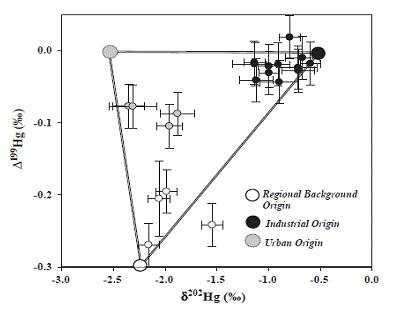 |
|
Fig.1 Hg isotope characteristic in sediments of East River(δ202Hg vs Δ199Hg)(Image by IGCAS)
|
 |
| Fig.2 Fractions of Hg sources in sediments of East River (X, Y, Z represent relative contribution of the sources industrial origin, urban origin, and regional background origin, respectively) (Image by IGCAS) |
Isotope geochemistry of mercury (Hg) is becoming a new frontier subject in earth sciences, and the application of stable Hg isotope ratios to trace the sources of environment pollution has been a hot spot in the fields of earth sciences and environmental sciences. Professor FENG Xinbin, leader of Biogeochemistry of Toxic Trace Elements Research Group at Institute of Geochemistry, Chinese Academy of Sciences (IGCAS), and his coworkers have made a series of progresses in this area.
Hg is one of the most toxic heavy metals in the environment. Many scientists have focused on the issues of Hg pollution. As one of the developed areas with rapid urbanization and industrialization, East River (Dongjiang in Chinese) of the Pearl River Delta is getting more and more seriously polluted by Hg. While being a research challenge of Hg biogeochemical process, accurate analysis of the source and the fate of Hg in river system is essential to the Hg pollution assessment and control. Recent studies have demonstrated that both abiotic and biotic processes may cause Hg isotope fractionation, and variations of Hg isotopic composition in the environment have been successfully employed to determine Hg pollution history, Hg sources and Hg pathways in nature.
Professor FENG Xinbin and his group members have developed a method for high-precision measurement of Hg isotope ratios using multiple collector inductively coupled plasma-spectrometry (MC-ICP-MS) with on-line Hg reduction technique. They also applied this technique to the Hg isotope research in East River. The results showed that the mass-dependent fraction (MDF) in the sediments varied significantly (δ202Hg: −2.35 to−0.60‰), and the mass-independent fraction (MIF) in the sediments also varied considerably (Δ199Hg: −0.02 to −0.27‰). The samples with the highest HgT (total mercury)located in the industrial area had the highest measured values of δ202Hg (−1.14‰ to −0.60‰), but insignificant MIF (Δ199Hg: −0.04 to −0.01‰). Meanwhile, the samples with the lowest HgT located in the background area showed the lowest measured values of δ202Hg (−2.16‰ to −1.55‰) and Δ199Hg (−0.20 to −0.27‰). Unlike the above two cases, the samples located in the urban area had relatively lower MDF (δ202Hg: −2.35‰ to −1.96‰) and small but significant MIF (Δ199Hg: −0.10‰ to −0.08‰) with relative higher HgT. The results demonstrated that the dominant Hg sources in Dongjiang sediments could be categorized as the regional background, urban and industrial sources. As shown in Fig.1, the combination of MDF/MIF signatures of the sediments indicated a triple mixing of natural, urban, and industrial Hg sources. The relative contribution of the three sources in the sediments of the studied area had been calculated (Fig.2). Their data clearly showed that Hg originated from different sources had distinct Hg isotope ratios and therefore Hg isotope compositions can be used to quantify the sources of Hg contamination to the sediment.
Relevant research achievements have been published in Chemical Geology (2011, 287:81-89), Chinese Journal of analytical chemistry (2010, 38(7):929-934), and Applied Geochemistry (2010, 25:1467-1477).
(Written by LIU Jinling, Edited by FENG Xinbin, XIAO Yi)